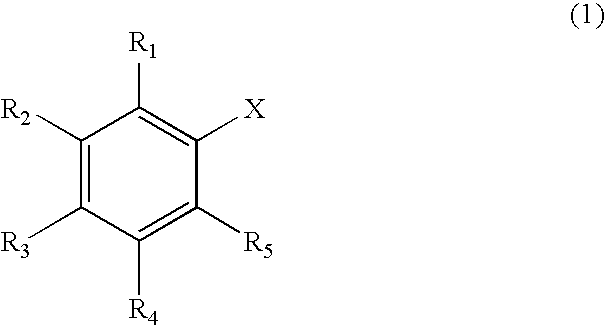Reagent for Organic Synthesis and Method of Organic Synthesis Reaction with the Reagent
a technology of organic synthesis and organic synthesis, which is applied in the direction of organic chemistry, organic chemistry, chemistry apparatus and processes, etc., can solve the problems of high cost and time consumption of process development, and achieve the effects of accelerating the research and development of pharmaceuticals, high degree of reactivity, and simplifying process developmen
- Summary
- Abstract
- Description
- Claims
- Application Information
AI Technical Summary
Benefits of technology
Problems solved by technology
Method used
Image
Examples
example 1
Synthesis of an Amine Having a Hydrophobic Carrier Group
[0095]One gram of 2,4-dihydroxybenzaldehyde, 8.4 g of 1-bromodocosane, and 6 g of potassium carbonate were dissolved in 20 ml of N,N-dimethylformamide, and reacted for 8 hours under a nitrogen gas flow at 80° C. After confirming the completion of the reaction by thin layer chromatography, 20 ml of toluene and 10 ml of water were added to the reaction liquid and stirred for 5 min at 80° C. The toluene layer was separated with a separatory funnel and after removal by distillation of the solvent, 50 ml of methanol were added and crystals were precipitated. This solution was subjected to suction filtration with a separatory funnel and 6.97 g of crude crystals w ere obtained. After dissolving the crude crystals in 200 ml of hexane at 70° C. and recrystallizing at room temperature, suction filtration was again carried out with a separatory funnel, and 4.7 g of the desired compound 3 were obtained. The yield was 85%. Compound 3; 2,4-b...
example 2
Synthesis of an Isocyanate Having a Hydrophobic Carrier Group
[0102]An amount of 371 mg (0.4 mmol) of 3,4,5-tris(octadecyloxy)benzoic acid was dissolved in 5 ml of toluene, and mixed with 412 mg (1.50 mmol) of diphenylphosphoryl azide (DPPA) and 30 mg (0.4 mmol) of triethylamine. This was stirred for 3 hours at room temperature, and then, heated to 90° C., and further reacted for 3.5 hours. After the completion of the reaction, acetonitrile was added, and after the precipitation of crystals, suction filtration was carried out with a separatory funnel and 333 mg of compound 6 were obtained. The yield was 90%. Compound 6; 5-isocyanate-1,2,3-tris(octadecyloxy)benzene.
[0103]The above reactions are shown below.
Structural Analysis of Compound 6
[0104]1H-NMR (CDCl3, 400 MHz) δ 6.20 (2H, s), 3.98-3.92 (6H, m), 1.82-1.69 (6H, m), 1.49-1.23 (84H, m), 0.88 (9H, t, J=6.60 Hz)
example 3
Synthesis of a Chloroformate Having a Hydrophobic Carrier Group
[0105]An amount of 4.43 g of methyl 3,5-bis(docosyloxy)benzoate was dissolved in 100 ml of tetrahydrofuran, and 240 mg of lithium aluminum hydride were introduced and stirred at room temperature. After the completion of the reaction was confirmed by thin layer chromatography, 1 ml of methanol was added and the reaction was stopped. After this, 30 ml of 1 N hydrochloric acid was added, and the extracted organic layer was washed two times with 30 ml of 1 N hydrochloric acid, once with 30 ml of a saturated aqueous solution of sodium hydrogen carbonate, and twice with 30 ml of saturated saline solution, and dried with magnesium sulfate. After vacuum distillation of the solution, 100 ml of methanol were added and crystals precipitated, and suction filtration was carried out using a separatory funnel to obtain 3.62 g of compound 7. The yield was 80%. Compound 7; 3,5-bis(docosyloxy)benzyl alcohol
[0106]An amount of 5 g of compou...
PUM
| Property | Measurement | Unit |
|---|---|---|
| Temperature | aaaaa | aaaaa |
Abstract
Description
Claims
Application Information
 Login to View More
Login to View More - R&D
- Intellectual Property
- Life Sciences
- Materials
- Tech Scout
- Unparalleled Data Quality
- Higher Quality Content
- 60% Fewer Hallucinations
Browse by: Latest US Patents, China's latest patents, Technical Efficacy Thesaurus, Application Domain, Technology Topic, Popular Technical Reports.
© 2025 PatSnap. All rights reserved.Legal|Privacy policy|Modern Slavery Act Transparency Statement|Sitemap|About US| Contact US: help@patsnap.com



